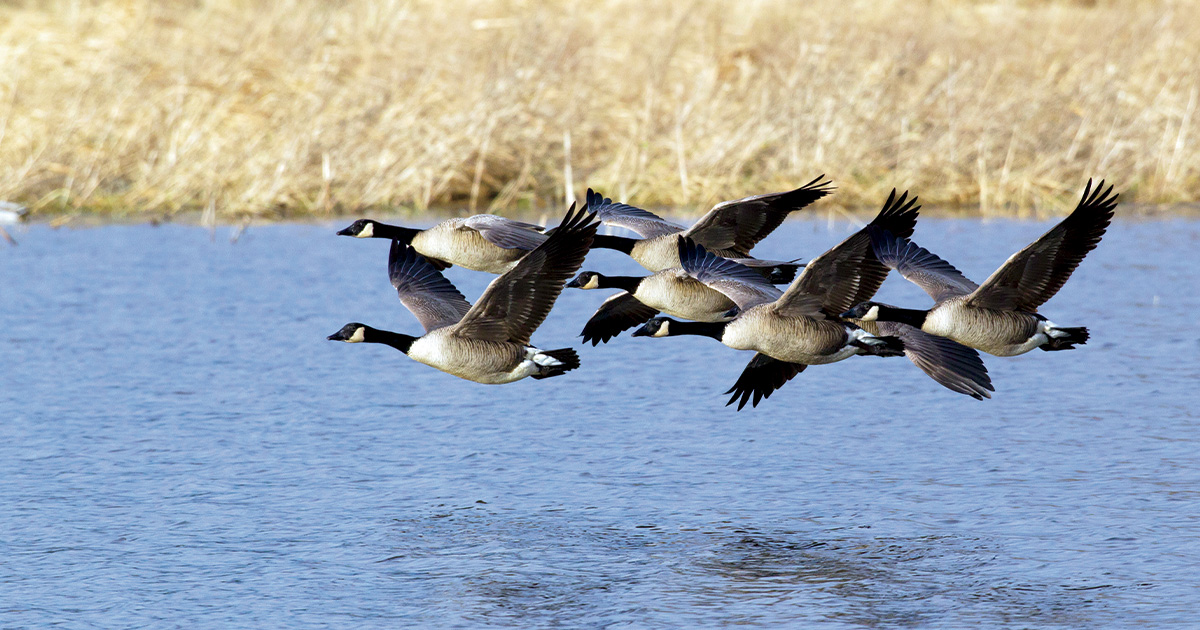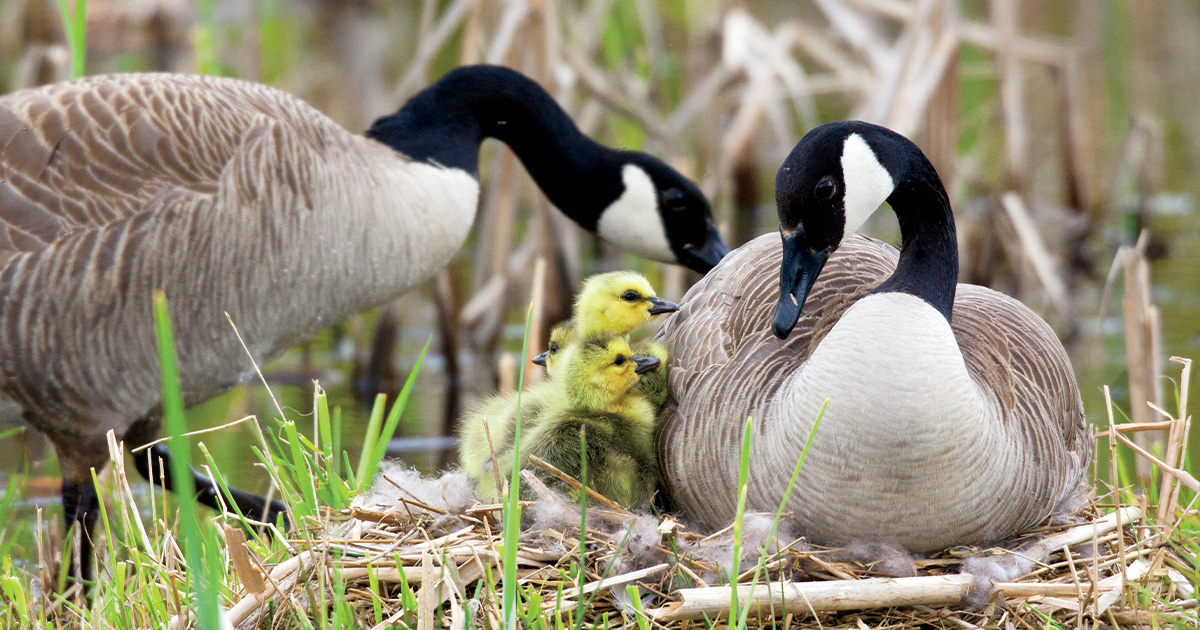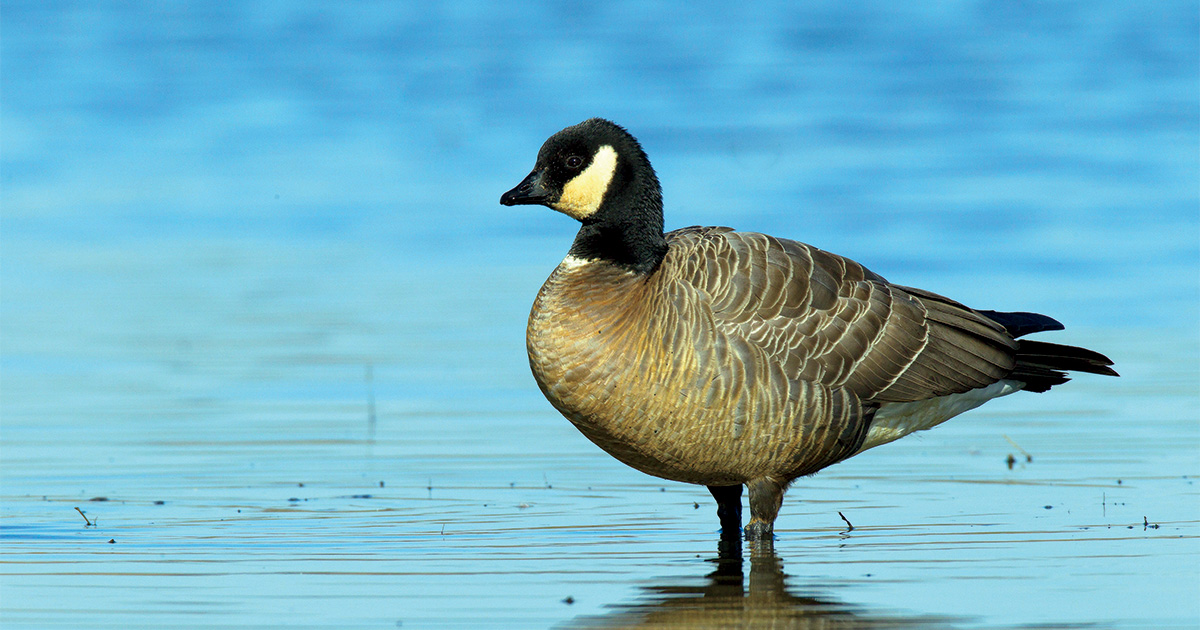Understanding Waterfowl: Story of the Giants
A closer look at the remarkable comeback of the giant Canada goose
A closer look at the remarkable comeback of the giant Canada goose
By David A. Graber and John M. Coluccy, Ph.D.

Waterfowl biologists believe there may be more Canada geese in North America today than at any time in history. Much of this abundance can be attributed to soaring populations of giant Canada geese. There are many misconceptions about the origins of these “resident” geese. Some believe they are wild birds that have lost their migratory instincts; others think they are semi-domesticated versions of barnyard geese. Actually, neither of these beliefs is true.
The giant Canada goose is the largest of seven generally recognized subspecies. Historically, the nesting range of these large geese extended from the prairies of southern Canada across the Upper Midwest to the Great Lakes and south through the Mississippi River Valley to Tennessee. Lewis and Clark observed Canada geese—almost certainly giants—nesting near the Missouri River during their westward journey in 1804.
By the early 20th century, however, giant Canada geese had been extirpated throughout most of their range as a result of unregulated hunting, egg collecting, and habitat destruction. In fact, this subspecies was thought to be extinct for nearly three decades until Harold C. Hanson of the Illinois Natural History Survey discovered a small remnant population near Rochester, Minnesota, during the early 1960s. Other isolated populations, including captive flocks kept by aviculturists, were subsequently identified and served as sources for restoration efforts led by conservation agencies. These birds were larger than other Canada geese and didn’t migrate in fall, which gave rise to the common misconception that they had domestic origins.
The reality is that giant Canada geese are naturally larger than other subspecies. Their large body size and distribution in temperate regions also explain why giant Canada geese do not migrate predictably, if at all. Instead, they hang around until extreme cold and deep snow force them to move south. Thus, giant Canada geese haven’t lost their migratory instincts as some believe; they never had them to begin with.
Today giant Canada geese can be found throughout their former range and in every U.S. state. Their numbers have increased exponentially in recent decades, and they now rival or outnumber migratory Canada geese in each of the flyways. Current estimates suggest that there are over 5 million Canada geese in North America. Of these, 3.8 million belong to the giant subspecies with roughly 1 million in the Atlantic Flyway, 1.4 million in the Mississippi Flyway, and 1.4 million in the Central Flyway. The current estimate of Canada geese in the Pacific Flyway is over half a million, but the specific percentage belonging to the giant subspecies is uncertain.

Why have giant Canada geese been so successful? In general, Canada geese are long-lived birds with relatively high survival and low reproductive rates. However, larger-bodied subspecies have higher survival and reproductive rates than their smaller cousins. Giant Canada geese begin nesting at a younger age, have larger clutches, and can defend themselves and their nests from most predators. Unlike their migratory counterparts—which nest in the Arctic and subarctic, where inclement weather often limits breeding success—giant Canada geese nest in temperate regions, where the weather is more favorable and the breeding season is longer. This gives the birds time to renest if their initial nesting attempts are unsuccessful.
Giant Canada geese have also benefited from manmade changes to their environment. Canada geese are grazers by trade and prefer the succulent new growth of grasses and sedges, which explains why these birds are so fond of manicured lawns, parks, and golf courses. But Canada geese also grub for roots and tubers and feed on various seeds and waste cereal grains. Their adaptable feeding habits and tolerance for people have enabled giant Canada geese to exploit urban and agricultural landscapes alike. In short, people have created ideal living conditions for these birds.
For waterfowlers, giant Canada geese now provide abundant hunting opportunities in areas where geese were once rare or absent. The annual U.S. Canada goose harvest has soared from an average of less than 500,000 birds during the mid-1960s to nearly 1.8 million in recent years. Much of this harvest increase can be attributed to the growth of giant Canada goose populations. In the early 1980s, giant Canada geese comprised only about 15 percent of the total Canada goose harvest in the Mississippi Flyway. This proportion increased to 40 percent in 1986–1990, 57 percent in 1991–1995, and more than 70 percent by 2010.
While nuisance goose issues have received plenty of attention lately and are indeed a serious problem in many areas, giant Canada geese remain a valuable resource appreciated by large segments of society. Their widespread distribution, year-round presence, and tolerance of humans make them ideal subjects for photography, ecological research, nature study, and environmental education. And for those of us with a passion for waterfowl, they offer a welcome connection to the wild in suburban settings.

North America’s White-Cheeked Geese: Canada geese are among the most diverse and widely distributed waterfowl in North America. Today, Canada geese nest from the Arctic to the southern United States. Generally, smaller Canada geese nest farther north, while the larger ones nest in the southern part of the breeding range.
Small Canada geese can complete their breeding cycle in a shorter time than large subspecies but are less tolerant of cold temperatures. As a result, small geese winter farther south than their larger cousins. Small Canadas also exhibit stronger migratory instincts because of the need to vacate their breeding grounds before the harsh Arctic winter arrives. In contrast, large-bodied Canada geese nest in more temperate regions, where a longer growing season accommodates their extended nesting and brood-rearing period. Their greater body size also allows them to winter farther north than their smaller cousins.
The considerable variation in size, appearance, and geographic distribution among Canada geese has caused considerable debate among taxonomists about how to classify these birds. For many years, waterfowl biologists recognized 11 subspecies of Canada geese, based mainly on body size and shape, plumage characteristics, and degree of geographic isolation among groups. However, in 2004, authorities declared the four smaller races of Canada geese as a separate species known as the cackling goose. This decision was based on DNA analysis, which allowed taxonomists to trace the birds’ lineage through genetics. Of the remaining seven generally recognized subspecies of Canada geese, the giant Canada goose is the largest, having an average adult weight of 12.5 pounds, compared to less than three pounds for some cackling geese.
David Graber is a regional conservation coordinator and Dr. John Coluccy is director of conservation planning at DU’s Great Lakes/Atlantic office in Ann Arbor, Michigan.
Fowl Fact: In addition to their migrations to and from breeding and wintering areas, many giant Canada geese also migrate long distances during summer to molting areas. These summer movements, which typically involve only sub-adult and nonbreeding adult geese, are known as molt migrations.